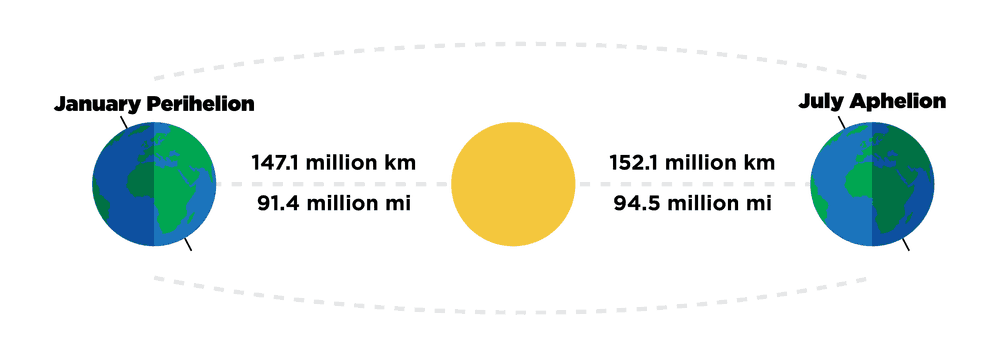As our lives are settling down after holiday parties, opening gifts, and long trips through the air and on the roads, sun worshipers are already thinking about warmer weather. Despite the fact that there are still 11 weeks to go in winter, they love this time of the year in the Northern Hemisphere when, just a few weeks past the winter solstice, the increase in daylight hours will gradually become more and more noticeable. This not only changes weather patterns across the country, but it can also affect the lives of truck drivers.
Changes in Latitudes, Changes in Attitudes
Our amount of daylight hours depends on latitude and how the Earth orbits the sun. Over the course of a year, the Earth’s 23.5-degree angle of tilt, which scientists call “obliquity,” doesn’t change. In other words, Earth’s northern axis is always pointing in the same direction in space, more or less toward Polaris (the North Star). But the orientation of Earth’s tilt with respect to the sun – our source of light and warmth – does change as we orbit the sun. In other words, the Northern Hemisphere is oriented toward the sun for half of the year and away from the sun for the other half. The same is true of the Southern Hemisphere.

As this orientation changes throughout the year, so does the distribution of sunlight on Earth’s surface at any given latitude. Even though Earth is farther away from the sun during summer compared to winter, when the Northern Hemisphere is oriented toward the sun, that region warms because of the corresponding increase in solar radiation. The sun’s rays are striking that part of Earth at an increasingly more direct angle through spring and summer. This, in turn, causes a seasonal variation in the intensity of sunlight reaching the surface.
Think of it this way: If you shine a flashlight at the ceiling, the region that is illuminated shrinks or grows depending on whether you point it directly at the ceiling or at an angle. Similarly, the sun’s energy spreads out over differing geographic areas when it reaches Earth’s surface. It is more concentrated during the Northern Hemisphere’s summer months when the sun is higher in the sky.
This spinning of Earth like a top explains our daily cycle of night and day, and its tilt also defines the length of daylight. Daylight hours are longest in each hemisphere’s summer. Between the winter and summer solstices, the number of daylight hours increases, and the rate of increase is larger at higher latitudes. So, daylight hours will increase faster in New York City compared to Miami, for example. The opposite of this whole process is true during each hemisphere’s winter.

At FreightWaves headquarters in Chattanooga, Tennessee, we’ll gain daylight hours on both sides of the day beginning in mid-January. In other words, this is when sunsets will keep getting later and sunrises will get earlier, not just one or the other. The latest sunrise of the season will be on January 14, with almost an extra hour of daylight a month later.
As the surface of the earth gets warmer in the Northern Hemisphere heading toward spring, the upper levels of the atmosphere often stay quite cold. So, temperatures can fall very quickly with altitude. This contributes to unstable conditions, which is why most severe thunderstorms and tornadoes happen in the U.S. from March through May. This also happens during the same time period in other places around the world at the mid-latitudes. As the upper atmosphere warms in the summer, thunderstorms can still pop up, but wind and tornado damage are less of a threat.
Impact on Truck Drivers
Proper rest is critical for driver health, success, and safety for everyone on the roads. As daylight hours increase from now until the summer solstice, truckers will have the opportunity to stay on the road longer, avoiding driving in darkness. This sounds like a good thing, but there’s a downside – they might get less sleep at night. Also, truckers who normally drive at night and try to sleep during the day will have to contend with more sunlight.
FreighWaves Market Expert Dean Croke notes that why the sky is blue is fundamental to understanding the sleep-wake process, as well as why truckers are so out of sync with hours of service regulations and so passionate about flexibility. The sky is blue because that’s the color that gets refracted (or bent) the most through Earth’s atmosphere. This is because of blue’s shorter wavelength bouncing off molecules in the air and scattering its light more than other colors. At sunset we see more red and orange in the sky because the blue light has been scattered out and away from the line of sight. As a result, our eyes are sensitive to blue light, which is also why you have a “Night Shift” setting in your iPhone display settings to reduce blue light at night.
In addition to the benefits of sleeping in 90-minute multiples, reducing outside noise, and keeping the right temperature in your sleep spaces, Croke recommends that drivers reduce or eliminate as much artificial light as possible. Their sleep environment has to be dark, and by “dark” he means so dark you can’t see your hand in front of your face. Even go as far as turning your alarm clock away from you so the green or blue LED lights don’t trick you brain into thinking it’s daylight outside. If you’re a shift worker, heavy double-insulated drapes (or blackout curtains) are a must, and you might even consider wearing a sleep mask.
Let’s enjoy the extra sunshine in the coming months, but let’s also stay aware of the rapidly changing weather that often accompanies it, and stay alert, well-rested, and safe on the roads.










